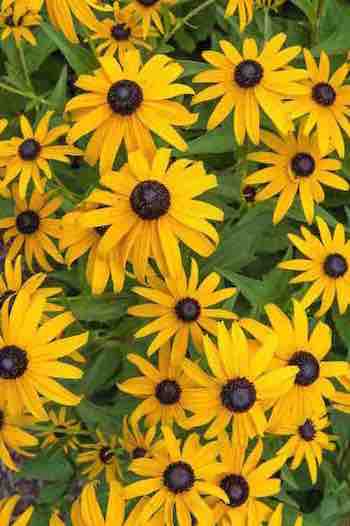- ONLINE SEED STORE
- >
- Flowers
- >
- 'Black Eyed Susan' - (Rudbeckia) - Flower Seeds - 400mg
'Black Eyed Susan' - (Rudbeckia) - Flower Seeds - 400mg
SKU:
CA$1.89
1.89
8.52
CA$1.89 - CA$8.52
Unavailable
per item
1,000+ Seeds per Pack!
A perfect eye catcher for your home-front flower-beds. Easy to grow and adaptable to most soils. ( no need to fertilize ) Height 60-90 cm (2-3ft.)
How To Grow:
3700 seeds/gram. This robust perennial will turn heads wherever planted and withstand more heat and drought than most. It is highly recommended to sow this type outdoors from September through October - select a site in full sun. This fall sowing allows any dormant seed to be naturally stratified over the winter. Seed can be started indoors in a soil-less mix from February to the beginning of March. Germinates at 20 C (70 F) in 14 to 21 days. Grow on under lights at a slightly cooler temperature before hardening off and transplanting outdoors to a sunny spot.
Blooming Season Begins: High Summer
Life Cycle: Perennial
Days to Emergence: 14 to 21
Light: Full Sun
Growth Habit: Sturdy
Height: Tall (> 70 cm)
Frost Tolerance: Winter Hardy
Degree of Difficulty: Easy
Heritage: Native of Ontario
Family Name: Asteraceae
Latin: Rudbeckia hirta
Suggested uses.: Native grass and flower blends.
Massing in sunny sites where soil is less than ideal.
Requires Stratification: For the seed from many native plants, late fall is the best time to sow seed directly outside. Why you ask? Simply put, many native plants produce seed that is viable but dormant. This means that while the seed has all the internal structures and nutrients required to germinate, the seed coat is so hard, water cannot pass through it and initiate germination. When seed is in this state, it is known as being dormant. Seed dormancy is a naturally selected for trait that protects the seed of many plants allowing them to safely overwinter and then be ready to sprout in more favourable conditions in spring.
The remedy to naturally breaking seed dormancy is typically the passing of time. In particular, seed overwintering outside and experiencing the natural freeze thaw cycles that occur in late fall, winter and early spring. This dormancy breaking process is called stratification.
3700 seeds/gram. This robust perennial will turn heads wherever planted and withstand more heat and drought than most. It is highly recommended to sow this type outdoors from September through October - select a site in full sun. This fall sowing allows any dormant seed to be naturally stratified over the winter. Seed can be started indoors in a soil-less mix from February to the beginning of March. Germinates at 20 C (70 F) in 14 to 21 days. Grow on under lights at a slightly cooler temperature before hardening off and transplanting outdoors to a sunny spot.
Blooming Season Begins: High Summer
Life Cycle: Perennial
Days to Emergence: 14 to 21
Light: Full Sun
Growth Habit: Sturdy
Height: Tall (> 70 cm)
Frost Tolerance: Winter Hardy
Degree of Difficulty: Easy
Heritage: Native of Ontario
Family Name: Asteraceae
Latin: Rudbeckia hirta
Suggested uses.: Native grass and flower blends.
Massing in sunny sites where soil is less than ideal.
Requires Stratification: For the seed from many native plants, late fall is the best time to sow seed directly outside. Why you ask? Simply put, many native plants produce seed that is viable but dormant. This means that while the seed has all the internal structures and nutrients required to germinate, the seed coat is so hard, water cannot pass through it and initiate germination. When seed is in this state, it is known as being dormant. Seed dormancy is a naturally selected for trait that protects the seed of many plants allowing them to safely overwinter and then be ready to sprout in more favourable conditions in spring.
The remedy to naturally breaking seed dormancy is typically the passing of time. In particular, seed overwintering outside and experiencing the natural freeze thaw cycles that occur in late fall, winter and early spring. This dormancy breaking process is called stratification.

